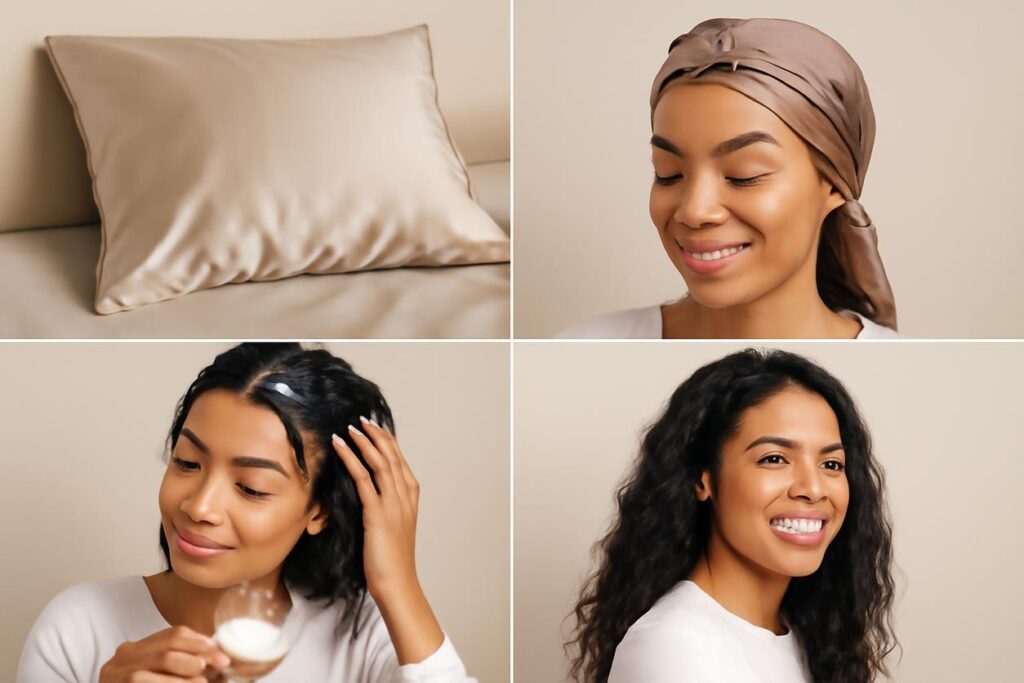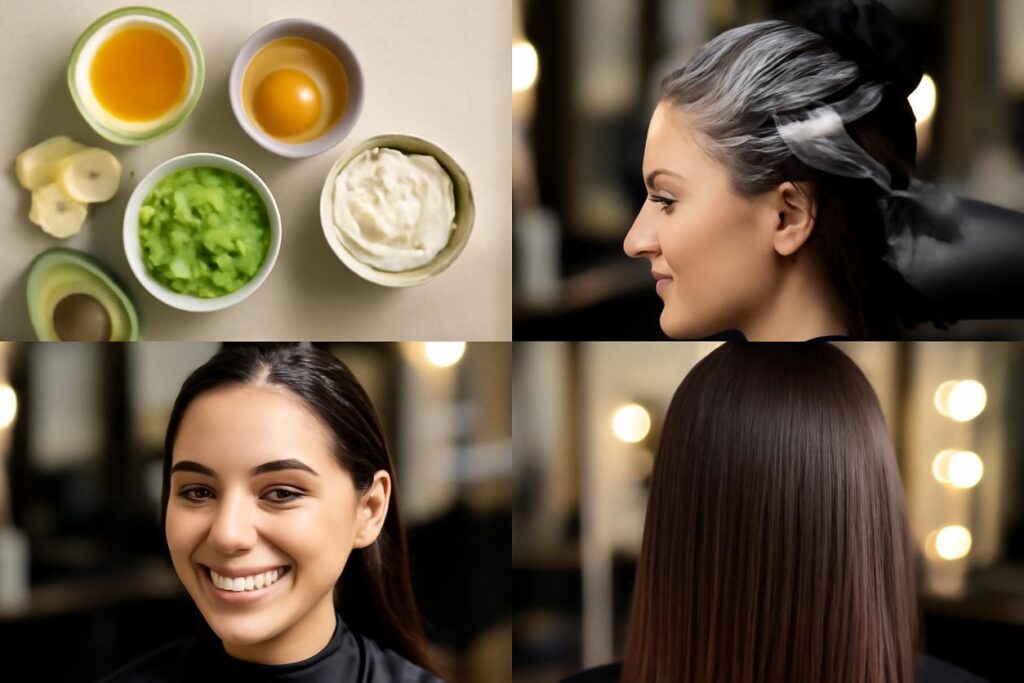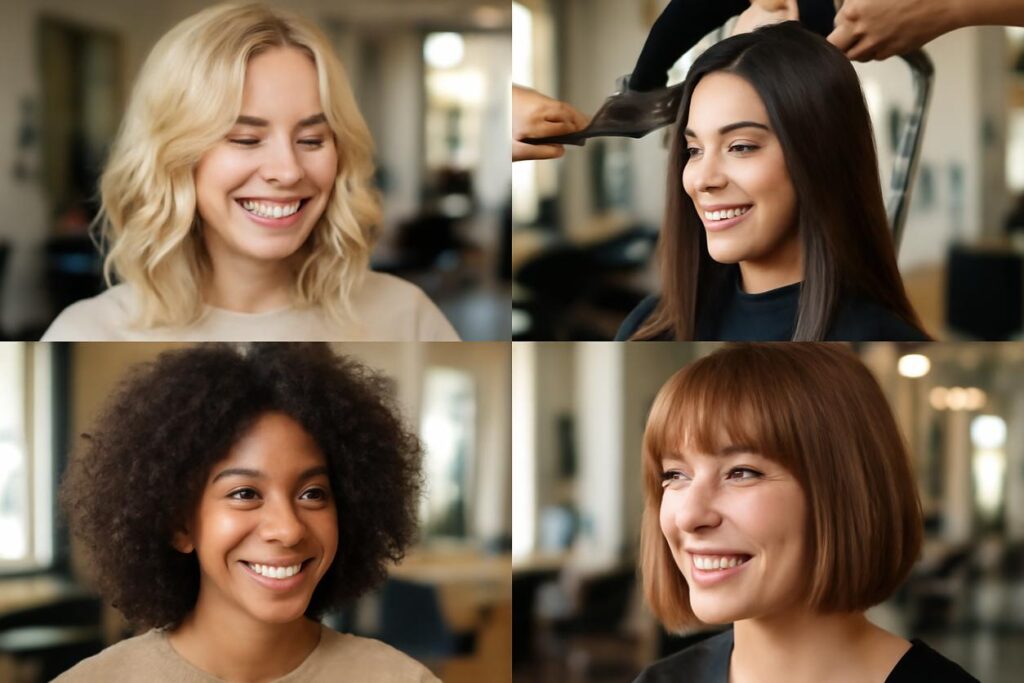Table of Contents
- Introduction – Why a Nightly Routine Changes Morning Hair
- The Science of Overnight Hair Repair
- Prep Steps Before Bedtime by Hair Type
- Easy Overnight Treatments and Recipes
- Protective Styles and Tools for Sleeping
- Sleep Environment Tips That Support Hair Health
- Quick 10-Minute Night Routine for Busy Evenings
- Weekly Maintenance Schedule and Tracking Progress
- What to Avoid: Common Overnight Mistakes
- Product Guidance Without Brand Bias
- Troubleshooting Common Morning Issues
- Frequently Asked Questions
- Summary and Practical Next Steps
Introduction – Why a Nightly Routine Changes Morning Hair
Imagine waking up with smoother, shinier, and more manageable hair every morning. It sounds like a dream, but it is achievable with a solid overnight hair care routine. While we often focus on our morning styling, the eight hours we spend sleeping are a golden opportunity for hair repair and rejuvenation. Tossing and turning can cause friction, leading to frizz, breakage, and tangled messes. By implementing a few simple steps before bed, you can protect your strands, infuse them with moisture, and let powerful treatments work their magic undisturbed. This guide will walk you through everything you need to know to transform your nighttime habits and, in turn, your morning hair reality.
The Science of Overnight Hair Repair
Your body enters a state of regeneration while you sleep, and your hair is no exception. During the night, blood flow to your hair follicles increases, delivering essential oxygen and nutrients that support growth. This is also when your body’s natural oil, sebum, is produced and distributed down the hair shaft, acting as a natural conditioner. A dedicated overnight hair care strategy capitalizes on these natural processes, creating the perfect environment for treatments to penetrate deeply and for hair to recover from daily stressors like pollution, heat styling, and sun exposure.
How Sleep Affects Hair Structure and Moisture
Each hair strand is covered by a protective layer called the cuticle, which looks like overlapping shingles. When damaged, these shingles lift, causing hair to look dull and feel rough. Quality sleep helps regulate hormones like cortisol and melatonin, which influence the hair growth cycle and cellular repair. When you apply treatments overnight, the stable, low-activity environment allows the ingredients to penetrate the cuticle more effectively, smoothing it down and locking in moisture. This uninterrupted time is far more effective than a quick 5-minute conditioner in the shower. Research shows that overall wellness, including sleep and nutrition, is foundational to hair health. For more on how internal health affects hair, you can explore hair nutrition research, which highlights the connection between diet and hair structure.
Prep Steps Before Bedtime by Hair Type
Effective overnight hair care is not one-size-fits-all. Your hair’s unique texture and density determine the best approach for pre-sleep preparation.
Fine and Straight Hair: Lightweight Options
The biggest challenge for fine hair is avoiding products that weigh it down, leaving it greasy and flat by morning. Your focus should be on protection and light hydration.
- Detangle Gently: Use a wide-tooth comb to gently remove any knots, starting from the ends and working your way up to the roots.
- Apply Sparingly: Use a lightweight, water-based hydrating mist or a few drops of a dry oil (like grapeseed or argan) on your ends only. Avoid the scalp.
- Style Loosely: A loose braid or a low, loose ponytail secured with a silk scrunchie can prevent tangles without creating kinks.
Thick and Coarse Hair: Deep Conditioning Approaches
Thick and coarse hair types are prone to dryness and can handle richer products. Your goal is to deeply moisturize and soften your strands overnight.
- Moisture is Key: Apply a leave-in conditioning cream or a small amount of hair butter from the mid-lengths to the ends.
- Seal the Ends: After applying a cream, add a drop or two of a heavier oil like castor or coconut oil to the very ends to seal in moisture and prevent splits.
- Secure and Protect: A loose bun on top of your head or two loose braids will keep your hair contained and protected from friction.
Curly and Textured Hair: Lock in Curl Pattern and Moisture
For curly and coily hair, the main goals of overnight hair care are to preserve the curl pattern, fight frizz, and retain moisture.
- Refresh and Hydrate: Lightly spritz your hair with water or a curl refresher spray to rehydrate your curls.
- Use the LOC/LCO Method: Apply a Leave-in conditioner, followed by an Oil, and then a Cream (LOC) or apply Leave-in, Cream, and then Oil (LCO). This layering technique is excellent for locking in moisture.
- Pineapple Your Hair: Gather your curls into a very loose, high ponytail on top of your head, secured with a gentle tie like a scrunchie. This protects the curls without squashing them.
Easy Overnight Treatments and Recipes
You do not need expensive products to give your hair a nourishing overnight boost. Simple, natural ingredients from your kitchen can work wonders.
Oil-Based Pre-Sleep Treatments
Hair oils can replenish lipids, add shine, and smooth the hair cuticle. Apply a small amount to dry or slightly damp hair before bed, focusing on the ends. Cover with a shower cap or silk scarf to protect your bedding.
- For Fine Hair: Argan oil, grapeseed oil, or jojoba oil are lightweight and absorb quickly.
- For Medium to Thick Hair: Coconut oil, olive oil, or avocado oil offer deeper conditioning.
- For Scalp Health: A few drops of peppermint or rosemary oil mixed with a carrier oil (like jojoba) can be massaged into the scalp to stimulate circulation.
Overnight Hydrating Masks (Natural DIY)
For a weekly deep treatment, try an easy DIY mask. Apply to hair, cover with a cap, and shampoo it out in the morning.
- Aloe Vera and Honey Mask: Mix two parts pure aloe vera gel with one part honey. Aloe vera hydrates and soothes the scalp, while honey is a natural humectant that draws in moisture.
- Yogurt and Banana Mask: Mash half a banana and mix it with two tablespoons of plain yogurt. This mask is rich in potassium and proteins, which can help strengthen hair.
Protective Styles and Tools for Sleeping
How you wear your hair to bed is just as important as what you put in it. The goal is to minimize friction and prevent tangles and breakage.
Silk or Satin Pillowcase and Wraps
Cotton pillowcases can absorb moisture from your hair and create friction, leading to frizz and breakage. Silk or satin has a smoother surface, allowing your hair to glide across it. This simple switch can make a significant difference in your morning hair texture. Alternatively, a silk or satin scarf, bonnet, or cap can wrap your hair securely, offering the same benefits.
Braids, Buns and Loose Protective Methods
Keeping your hair contained prevents it from tangling as you move in your sleep. The key is to keep these styles loose to avoid tension on your scalp and hair follicles.
- Loose Braid: A single, loose plait is great for straight or wavy hair. It prevents knots and can create gentle waves.
- High Bun (Pineapple): Ideal for curly hair to protect the curl pattern.
- Top Knot: A loose bun piled on top of your head keeps hair off your neck and face.
For more insight on how styling impacts hair health, you can review protective styling research, which often covers topics like traction alopecia and breakage prevention.
Sleep Environment Tips That Support Hair Health
Your bedroom environment can also play a role in your hair’s health. If the air in your room is very dry, especially during winter, it can strip moisture from your hair and skin. Consider using a humidifier at night to add moisture back into the air. This can help keep your hair and scalp hydrated, reducing dryness and static.
Quick 10-Minute Night Routine for Busy Evenings
Even on your busiest days, you can fit in a quick overnight hair care routine. Here is a simple plan for 2025 and beyond:
- (2 Minutes) Gently Detangle: Use your fingers or a wide-tooth comb to remove major knots.
- (3 Minutes) Apply Product: Depending on your hair type, apply a leave-in conditioner, a few drops of oil to the ends, or a hydrating mist.
- (3 Minutes) Style for Sleep: Put your hair into a loose protective style like a braid, bun, or pineapple.
- (2 Minutes) Protect: Swap to a silk pillowcase or tie your hair up in a silk scarf or bonnet.
Weekly Maintenance Schedule and Tracking Progress
Consistency is key to seeing results. Use a simple schedule to incorporate different aspects of overnight hair care into your week.
| Day | Activity | Focus |
|---|---|---|
| Monday | Basic Routine | Detangle, protect with silk pillowcase. |
| Tuesday | Targeted Treatment | Add a leave-in conditioner or serum. |
| Wednesday | Scalp Care | Gentle scalp massage with a few drops of oil. |
| Thursday | Basic Routine | Detangle, protect with a loose style. |
| Friday | Deep Treatment | Apply an overnight DIY mask or oil treatment. |
| Saturday | Basic Routine | Detangle, protect with silk pillowcase. |
| Sunday | Rest Day | Give your hair a break, prepare for the week. |
Take a photo of your hair on day one and another after a month to track visible improvements in shine, smoothness, and length retention.
What to Avoid: Common Overnight Mistakes
Knowing what not to do is as important as knowing what to do. Avoid these common pitfalls:
- Sleeping with Wet Hair: Hair is most fragile when wet. Tossing and turning can stretch and snap wet strands. Always aim to have your hair at least 80% dry before bed.
- Using Tight Hair Ties: Tight elastic bands can cause breakage and create harsh demarcation lines. Opt for gentle options like silk or satin scrunchies or spiral hair ties.
- Applying Too Much Product: Overloading your hair with heavy oils or creams can lead to buildup and weigh it down. A little goes a long way.
- Forgetting Your Scalp: A healthy scalp grows healthy hair. Neglecting it can lead to issues like dryness or oiliness.
Product Guidance Without Brand Bias
When selecting products for your overnight hair care routine, focus on the ingredients rather than the brand name. Look for formulations that cater to your hair’s needs.
- For Hydration: Look for humectants like glycerin, hyaluronic acid, and aloe vera, which attract and hold moisture.
- For Sealing and Smoothing: Natural oils and butters (like shea butter, argan oil, and coconut oil) are excellent for sealing the hair cuticle. For those who do not mind them, silicones can also provide excellent slip and shine, but choose lighter ones if you have fine hair.
- For Strengthening: Ingredients like hydrolyzed proteins (wheat, soy, or silk) and keratin can help temporarily patch gaps in the hair cuticle, adding strength.
Troubleshooting Common Morning Issues
Even with a great routine, you might face some challenges. Here is how to handle them:
- Greasy Roots: You may be applying products too close to your scalp. Focus application on the mid-lengths and ends. A bit of dry shampoo at the roots can also help absorb excess oil.
- Frizzy Halo: Your hair might need more moisture, or your protective covering may have slipped off. Try a more secure bonnet or scarf. A silk pillowcase is a great backup.
- Flat or Misshapen Hair: Your protective style might be too tight or not positioned correctly. Experiment with a looser style or a different placement (e.g., a higher or lower bun). A quick mist of water in the morning can help reshape your hair.
Frequently Asked Questions
Is it okay to do overnight hair care every night?
Yes, basic overnight care like using a silk pillowcase and a loose protective style is beneficial every night. Deeper treatments like masks or heavy oils are best done once or twice a week.
Can overnight hair care help with hair growth?
While it does not directly make hair grow faster, it creates a healthier environment for growth. By preventing breakage, it helps you retain length, making your hair appear to grow longer and fuller. Understanding conditions that affect hair can provide more context; for reliable information, sources like the NHS on hair loss can be helpful.
Will overnight treatments stain my pillowcase?
They can, which is why it is recommended to wear a shower cap, silk bonnet, or an old scarf over your hair after applying a treatment. You can also place an old towel over your pillow as an extra precaution.
Summary and Practical Next Steps
Adopting an overnight hair care routine is a simple yet powerful way to achieve healthier, more manageable hair with minimal effort. By understanding your hair type, choosing the right treatments, and protecting your strands from physical damage while you sleep, you are setting yourself up for better hair days, every day. Start small by incorporating one or two new habits, like switching to a silk pillowcase or trying a loose braid. As you get comfortable, you can build a comprehensive weekly schedule that addresses all your hair needs. Your hair will thank you for it.






